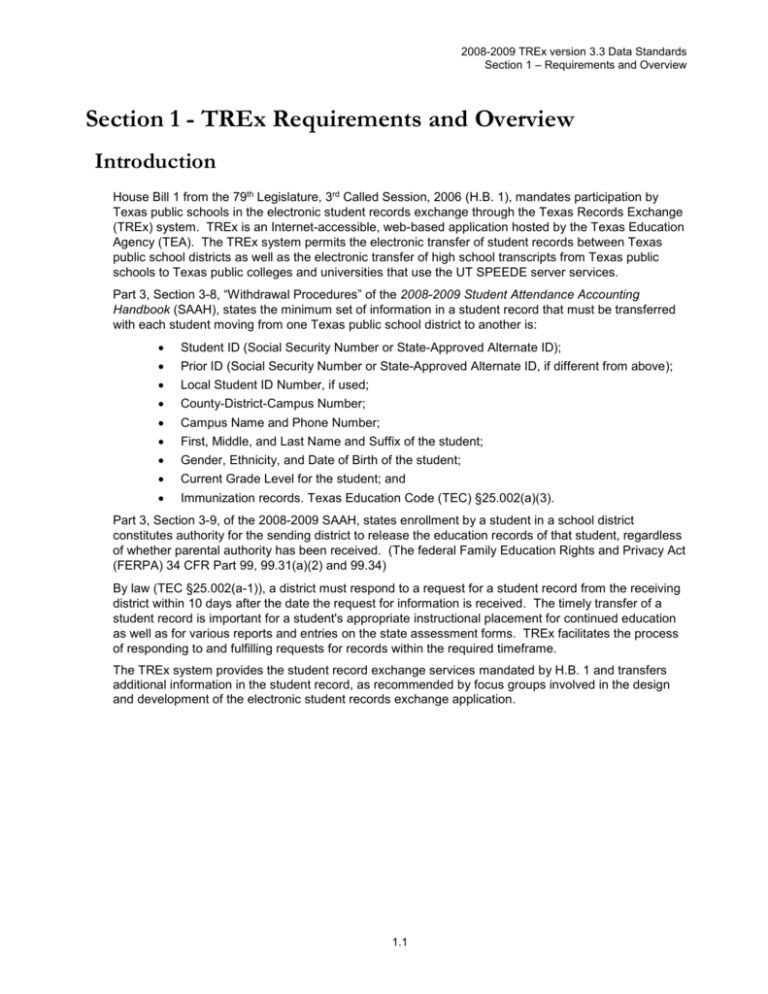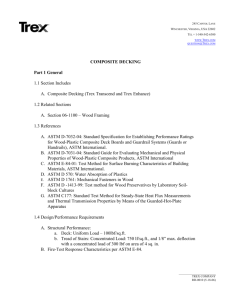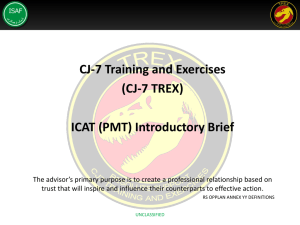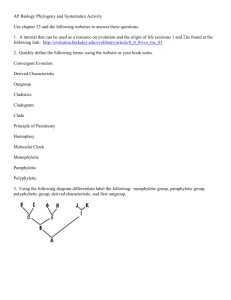Texas Education Agency
advertisement

2008-2009 TREx version 3.3 Data Standards Section 1 – Requirements and Overview Section 1 - TREx Requirements and Overview Introduction House Bill 1 from the 79th Legislature, 3rd Called Session, 2006 (H.B. 1), mandates participation by Texas public schools in the electronic student records exchange through the Texas Records Exchange (TREx) system. TREx is an Internet-accessible, web-based application hosted by the Texas Education Agency (TEA). The TREx system permits the electronic transfer of student records between Texas public school districts as well as the electronic transfer of high school transcripts from Texas public schools to Texas public colleges and universities that use the UT SPEEDE server services. Part 3, Section 3-8, “Withdrawal Procedures” of the 2008-2009 Student Attendance Accounting Handbook (SAAH), states the minimum set of information in a student record that must be transferred with each student moving from one Texas public school district to another is: Student ID (Social Security Number or State-Approved Alternate ID); Prior ID (Social Security Number or State-Approved Alternate ID, if different from above); Local Student ID Number, if used; County-District-Campus Number; Campus Name and Phone Number; First, Middle, and Last Name and Suffix of the student; Gender, Ethnicity, and Date of Birth of the student; Current Grade Level for the student; and Immunization records. Texas Education Code (TEC) §25.002(a)(3). Part 3, Section 3-9, of the 2008-2009 SAAH, states enrollment by a student in a school district constitutes authority for the sending district to release the education records of that student, regardless of whether parental authority has been received. (The federal Family Education Rights and Privacy Act (FERPA) 34 CFR Part 99, 99.31(a)(2) and 99.34) By law (TEC §25.002(a-1)), a district must respond to a request for a student record from the receiving district within 10 days after the date the request for information is received. The timely transfer of a student record is important for a student's appropriate instructional placement for continued education as well as for various reports and entries on the state assessment forms. TREx facilitates the process of responding to and fulfilling requests for records within the required timeframe. The TREx system provides the student record exchange services mandated by H.B. 1 and transfers additional information in the student record, as recommended by focus groups involved in the design and development of the electronic student records exchange application. 1.1 2008-2009 TREx version 3.3 Data Standards Section 1 – Requirements and Overview Responsibilities The following sections describe the responsibilities of each participant within the TREx process. School Districts and Campuses Response to Request Districts must ensure that copies of student records are made available to schools to which students transfer. The transfer of a student record to another school district/charter may not be withheld for any reason. By law, (TEC §25.002(a-1)), a district must respond to a request for a student record from the receiving district within 10 days. Privacy TEC §25.002 and FERPA 34 CFR Part 99, 99.31(a)(2) and 99.34 protect the right of access to the student record. Districts must protect the private information on student records and transcripts from unauthorized individuals. TREx encryption ensures protection of the data during transmission and within the TREx process; however, once the data are downloaded, data security becomes the responsibility of the receiving school district/campus. Local Student Information System Student record information comes directly from the local student information system. TREx requires district/campus registrars to upload an XML-based extract file from a local student information system and transmit it through TREx to another institution. The receiving district/campus has the ability to download and store the data once the district/campus accepts the student record/transcript through TREx. Although information updates may result from the exchange of student records between districts, TREx does not update the local student information systems automatically. Districts/campuses update, maintain, and store this data in the local student information system. Note: It is important to remember that data in TREx are transitory. The data held for campus/district review are automatically purged from TREx within a set number of days. Data Accuracy Campuses and districts are responsible for the accuracy and validity of the data in the student records and transcripts. TREx includes edits and validations of the data that are related to formatting, business rules, and data integrity for transmission and storage purposes. TREx edits and validations are not related to the accuracy of the data. Sending districts and campuses certify the content of their TREx data transmissions (high school transcripts) by electronically signing the "Registrar’s Statement of Approval" available in TREx. The electronic signature certifies that the district has taken measures to verify the accuracy and the authenticity of the data in the high school transcript. The electronically signed form is stored on a secured TEA server and a copy is emailed to the registrars. Note: Based on new or updated information gathered through the TREx process, campuses and districts should update data within their local student information systems. TREx does not update data in local systems. TEASE Approval Districts and campuses obtain access to the TREx application through the Texas Education Agency Secure Environment (TEASE) authentication approval process. Each TREx user must complete the TEA online automated TEASE application form found at http://www.tea.state.tx.us/webappaccess/AppRef.htm and follow the approval procedures as noted on the web page. The TREx TEASE approval process began in August 2007. 1.2 2008-2009 TREx version 3.3 Data Standards Section 1 – Requirements and Overview The superintendent or authorized designee must approve all TEASE authorization requests before the requests are sent to TEA for approval. Note: Districts and campuses must submit TREx requests for TEASE access through the automated process available from the TEA web site. The TREx project does not accept hardcopy TEASE request forms. Equipment Requirements Scanner Software Requirements Microsoft Internet Explorer (IE) version 6.0 or higher Email access Minimum System Requirements The PC must have Internet access The Internet browser must be able to support SSL 2.0 standards – 128 encryption File Requirements The suggested default file location for attachments (scanned documents) is: C:\TREx. File size limitation: 10MB Extract files are submitted to TREx with the following naming convention: ####LastName_FirstName_descriptor #### = last 4 digits of the Student ID LastName = student’s last name FirstName = student’s first name Descriptor = stu (student record) Order 1 Description Example Last 4 digits of Student ID 2 3 4 5 6 Student Last Name underscore Student First Name underscore 3-character descriptor Doe _ John _ stu 1234 Example: 1234Doe_John_stu Note: Extract files do not require an extension of .XML to be accepted by TREx. As long as the XML format meets the schema requirements, TREx will accept the file with any extension. Attachments are submitted to TREx with the following naming convention: ####LastName_FirstName_Descriptor## #### = last 4 digits of the Student ID LastName = student’s last name FirstName = student’s first name Descriptor = le (Limited English Proficiency (LEP) attachment) im (Immunization record attachment) gt (Gifted/Talented (GT) attachment, such as a GT profile) ms (Miscellaneous record) ot (Other – to be used for any document that the district is uncomfortable giving any indication of what is contained within the document) tl (Transcript Legend) ## - two-digit generation number (01-99)* to allow for multiple attachments within type 1.3 2008-2009 TREx version 3.3 Data Standards Section 1 – Requirements and Overview *Note: Numbers 81-89 under ms (miscellaneous record) are strictly reserved for Disciplinary Action attachments. Numbers 91-99 under ms (miscellaneous record) are strictly reserved for Individual Education Plan (IEP) attachments. Order Description Example 1 2 3 4 5 6 7 Last 4 digits of Student ID Student Last Name underscore Student First Name underscore 2character descriptor 2-digit generation number 1234 Doe _ John _ ot 91 Example: 1234Doe_John_gt01 (indicates the attachment is a GT record) 1234Doe_John_ms91 (indicates the attachment is related to an IEP) 1234Doe_John_ms01 (indicates miscellaneous attachment is not IEP-related) Record Ownership and Storage The permanent retention of student records and transcripts continues to be the responsibility of districts/campuses and does not change with the implementation of TREx. Districts must maintain high school transcripts permanently (19 Texas Administrative Code (TAC) §74.14(a)). TEA does not store the transcript or academic achievement record (AAR) data transmitted through the TREx system. TREx automatically purges high school transcript data in the same manner and timeframe as student record extract files. Public Colleges and Universities Public colleges and universities are responsible for the timely processing of student transcript records received from TREx through the UT SPEEDE server. Education Service Centers (ESCs) Training to Districts and Campuses While campuses and districts process the transfer of student records and high school transcripts, the ESCs provide support and training on the TREx application and processes to districts. The instruction on TREx provided by ESCs to school districts and campuses may include: overall data flow and process; data element definitions; data transmission requirements; and reporting options. TEASE Approval ESCs obtain access to the TREx application through the TEASE authentication approval process. Each TREx user must complete the TEA online automated TEASE application form found at http://www.tea.state.tx.us/webappaccess/AppRef.htm and follow the approval procedures as noted on the web page. Note: The current process and procedures for handling closed charter school record exchanges remains outside of the TREx process initially; therefore, a separate TEASE role at the ESC level to allow record transfers through TREx is not included at this time. 1.4 2008-2009 TREx version 3.3 Data Standards Section 1 – Requirements and Overview Texas Education Agency TEA is responsible for the implementation, administration, and maintenance of the TREx application. Privacy H.B. 1 (79th Legislature, 3rd Called Session, 2006) mandates that TEA collect and transfer student data for educational purposes. The federal Family Education Rights and Privacy Act (FERPA) regulations mandate that personally identifiable student data be kept confidential. TEA must follow all FERPA requirements protecting the confidential information in student records and transcripts. Security TEA is responsible for the security of the data while in transit. TREx has multiple levels of system and application-level security to protect the privacy of student education records as established by FERPA including: TREx has a multi-layered security protocol that safeguards the network. Authentication blocks users until they are approved by the TEASE (Texas Education Agency Secure Environment) system. Extensive Access Control Lists (ACLs) apply policies that keep users from reaching restricted resources. Training to ESCs TEA provides training and training materials for the TREx application to the ESCs and provides information to assist ESCs train the districts and/or campuses. TEA and ESCs have an established relationship in providing a train-the-trainer approach. This same training approach is used with the TREx application. Training materials may be accessed from the TREx project web site at: http://www.tea.state.tx.us/trex/training.html. Record Storage TEA stores all TREx data, including attachments extracted from a local student information system, in a relational database within TREx for a limited number of days. TEA sets and maintains this parameter. Note: At no time during the transmission or the temporary storage of the data does TEA take ownership of the data. The permanent retention of student records and transcripts continues to be the responsibility of districts/campuses and does not change with the implementation of TREx. TEASE Request Processing The TEA Computer Access group approves and notifies the requestor by email when the TEASE ID is ready to use. (The email notifications from the Computer Access group include basic instructions for the initial login and password change.) 1.5 2008-2009 TREx version 3.3 Data Standards Section 1 – Requirements and Overview TEASE Roles Following is a preliminary list of TREx roles and privileges in TEASE that will be available by Phase 2. Updates to this list may be necessary for future TREx Data Standards releases. TREx Role Name Campus Registrar/Counselor Campus Registrar/Counselor Multiple Campuses Campus View-Only District Registrar/Counselor Examples of Users Counselors, Registrars, Admissions Office staff Counselors, Registrars, Admissions Office staff responsible for more than one campus but not for a full district Principal, VicePrincipal, Secretary District-wide Admissions staff or District Registrar District Registrar/Counselor Multiple Districts Counselors, Registrars, Admissions Office staff responsible for more than one district District View-Only District staff, TREx Coordinator ESC View-Only ESC TREx Coordinator/Trainer SIS Vendors Agency TREx staff and managers Agency technical staff supporting TREx Vendor TEA View-Only TEA Administrator Privileges Send, receive, accept, download, view, track, and approve all information in student records or transcripts for a campus; generate and view TREx reports for a campus; manually enter student record/transcript data for a campus; attach TEA-approved graduation diploma seals and send official high school transcripts for graduates at a campus Send, receive, accept, download, view, track, and approve all information in student records or transcripts for a campus; generate and view TREx reports for a campus; manually enter student record/transcript data for a campus; attach TEA-approved graduation diploma seals and send official high school transcripts for graduates at more than one campus Track and view TREx transaction history logs for a campus; view TREx summary reports Send, receive, accept, download, view, track, and approve all information in student records or transcripts for all campuses within a district; generate and view TREx reports for all campuses within a district; manually enter student record/transcript data for all campuses within a district; attach TEA-approved graduation diploma seals and send official high school transcripts for graduates for any campus within a district Send, receive, accept, download, view, track, and approve all information in student records or transcripts for all campuses within a district; generate and view TREx reports for all campuses within a district; manually enter student record/transcript data for all campuses within a district; attach TEA-approved graduation diploma seals and send official high school transcripts for graduates for any campus within multiple districts Track and view transaction history logs district-wide (all campuses within a district); view TREx summary reports for all campuses in the district Track and view transaction history; view TREx summary reports for all districts or campuses within the ESC region Validate XML extract files against TREx schema. Track and view transaction history logs; view TREx summary reports for all campuses/districts within the state Perform technical administrative and trouble-shooting functions on a statewide level; generate and view reports Please note that for Phase 1, only the Campus Registrar role will be available. 1.6 2008-2009 TREx version 3.3 Data Standards Section 1 – Requirements and Overview TREx Process Overview As Texas students transfer between school districts/campuses or move on to a college or university after graduation, Texas public school campus registrars receive requests for the transfer of student records to school districts and high school transcripts to institutions of higher education (IHE). These types of record exchange requests occur year-round, with specific patterns of heavier activity based on student semester completion. TREx is designed to meet the requirements for districts and campuses at all times of the year. Although TREx provides a manual entry capability to create student records or transcripts, most districts transmit the data through TREx in an XML-based extract file. The file is referred to as an “extract” file because it is created through a local vendor-supported process that extracts the student record or transcript information from a district’s local student information system. On a per-student basis, districts/campuses upload data (extract file) into TREx and transmit the data to the TREx server. TREx sends the data to the receiving district/campus or to the UT SPEEDE server (if the extract file is for a transcript) and subsequently deletes data within a set number of calendar days. The number of days that TREx holds a request or extract file is limited from the time it is initially transmitted to TREx. Each TREx transaction is date-stamped, thereby informing users of the number of days remaining before TREx purges the data. Student Records In TREx, a “student record” is an individual student record sent between one Texas public school district/campus and another Texas public school district/campus. A student record in TREx may apply to grades Pre-Kindergarten through 12 and should include data for all of the grade levels, if available. Data extracted from the local student information system for a student record include: Student identification data; Student demographic data; School data; Enrollment/withdrawal data; Student program and test data; Current year attendance data; Current year coursework; Immunization record; and Unexpired disciplinary action data. When a student record exchange request is an inbound type, it originates from a receiving district. In other words, the student has transferred and the district receiving that student needs his or her student records from the campus of last enrollment. The receiving registrar creates a record request in TREx, which is transmitted to the student’s previous campus. TREx notifies the exiting registrar (at the campus of last enrollment) by email that a request exists if the campus does not open the request within 24 hours of its being sent. The exiting registrar clicks on the request link from the TREx home page and verifies through local records that the student did attend that campus. If the request is not valid for that campus (i.e., the student was not enrolled at the campus), the exiting registrar rejects the request. TREx logs the rejected transaction status and sends the receiving registrar notification. If the request is valid, the exiting registrar creates an extract file from the local student information system and transmits the student record through TREx. If the request is valid but the student record is not available from a local student information system, the registrar can manually enter the data in TREx. 1.7 2008-2009 TREx version 3.3 Data Standards Section 1 – Requirements and Overview High School Transcripts A high school transcript record in TREx refers to the official high school transcript or academic achievement record (AAR) for Grades 9-12. The transcript is an official and permanent record of a student's academic performance during high school and, in some cases, of high school courses completed in middle school or junior high school (TEC §28.025(e)). When the request is an outbound type (a high school student requesting a transcript be sent to a college), the exiting registrar uploads the student’s high school transcript to TREx via an extract file of data from the local student information system, selects the college, and transmits the document. Sending districts and campuses certify the content of the high school transcript data by electronically signing the "Registrar’s Statement of Approval" available in TREx. The electronic signature certifies that the district has taken measures to verify the accuracy and the authenticity of the data in the high school transcript. As with student records, registrars have the ability to manually enter transcripts in TREx if the data are not available in the local student information system. Note: The campus or district procedures for how high school students request a transcript be sent to a college or university remain unchanged; only the means by which the request is fulfilled changes with the implementation of the TREx system. TREx presents the transcript in the required standard AAR format with the approved graduation seal to distinguish among various graduation programs (TEC §28.025(e)). The types of graduation programs include minimum high school program, recommended high school program, and distinguished high school program. Note: Graduation seals adopted by the State Board of Education to indicate completion of each of the programs must be affixed to each student’s AAR-transcript to indicate which of the graduation plans the student completed (19 TAC §74.14(d)). TREx transmits the high school transcript to the UT SPEEDE server, which translates it as needed for the selected public university or college. The receiving registrar at the college or university accesses the high school transcripts from the SPEEDE server. Note: TREx includes a campus/district transcript legend option that creates a pdf, which can be attached to all transcript records. However, the UT SPEEDE server service does not accept attachments. Information on the EDI to TREx mapping performed for transcripts sent to the UT SPEEDE server service can be referenced on the TREx project web site at: http://www.tea.state.tx.us/trex/ihetools/. 1.8 2008-2009 TREx version 3.3 Data Standards Section 1 – Requirements and Overview Following is an illustration of the general TREx process flow for Student Records transmitted between Texas public school districts: 1. Student transfers to new campus/district 2. Receiving registrar logs into TEASE to authenticate 5. Receiving registrar determines last school of enrollment for student and initiates a request for student record 3. Receiving registrar accesses TREx 7. Exiting registrar makes a decision to fulfill, hold or reject the request 6. Exiting registrar receives request for student record through TREx Fulfill Request OR Hold Request 8A. Exiting registrar determines if the most current data are in TREx or the local SIS TREx Data Source 4. Receiving registrar has the option to enter identifying information and search for the student’s last school of enrollment OR OR 8B. Exiting registrar designates the request as On Hold in TREx 8C. Exiting registrar rejects an invalid request in TREx COMPLETE until further action is required COMPLETE Local SIS Data Source OR 8A.1. Exiting registrar locates and extracts student record from the local SIS 8A.2. Exiting registrar uploads the local SIS extract into TREx 9. Exiting registrar selects student’s record from TREx and sends it to requesting institution 10. Receiving registrar receives student’s record in TREx COMPLETE 1.9 Reject Request Manual Entry 8B.1. Exiting registrar keys in all of the record data into TREx 2008-2009 TREx version 3.3 Data Standards Section 1 – Requirements and Overview Following is an illustration of the general TREx process flow for High School Transcripts being sent to colleges and universities from Texas public high schools: 1. Student requests that High School Registrar send transcript to a college or university 2. High School Registrar logs into TEASE to authenticate 4. High School Registrar accesses transcript record in local student information system 5. High School Registrar creates extract file 7. Data are verified and approved 8. High School Registrar selects the college or university from TREx list 3. High School Registrar accesses TREx application 6. High School Registrar uploads extract file to TREx 9. High School Registrar sends transcript through TREx to UT SPEEDE server 10. College registrar checks SPEEDE server for incoming transcripts 11. College registrar or Admissions Office downloads transcript from SPEEDE server COMPLETE 1.10 2008-2009 TREx version 3.3 Data Standards Section 1 – Requirements and Overview TREx Functionality As the work flow diagrams illustrate, functionality within TREx includes the ability to search student records, upload the XML-based extract files from local student information systems to TREx and transmit the extract file to the selected public school or public IHE. Additional TREx functionality includes the ability to review data received, download the data, fulfill a request, hold a request (for example if current coursework in the student record requires updating with final grades), and reject a request if it is invalid. An example of an invalid request is a student record request for a student who did not attend the campus receiving the request for a student record. Managing Student Records TREx provides a user home page that includes a group of Managing Student Records functions. This group of functions allows the users to search through student records and transcripts (if applicable) within their Manage Records folder on the home page. Registrars can view the student record or transcript, as well as upload to TREx or download records from TREx for their campus/district (as defined by their TEASE role). Additionally registrars can track inbound and outbound requests by their tracking number and view the full transaction history of those requests from the Manage Student Records page. Send Record Request TREx is designed to meet the needs of both the exiting and receiving registrars in locating the correct student records. For a receiving registrar, the TREx process begins with a request created in TREx that is presented to an exiting registrar. A TREx request includes the following key elements: Student ID; First Name, Middle Name, Last Name, Suffix (generation code); Date of Birth; Gender; Ethnicity; and Information of the requesting district/campus. A receiving campus can retrieve the request from the TREx home page. TREx sends an email notification to receiving campuses if no transaction status change is logged after 24 hours of receipt of an inbound request. Search Capabilities TREx interfaces with another TEA application to assist registrars in searching for the last campus attended by for a student. Registrars perform searches by providing key elements found in the request itself. If the student record exists for a campus, TREx displays a single student or a list of students and the registrar can select the correct student. If no students match the request, the registrar has to rely on alternate means to obtain the information, such as searching by student ID or name. TREx also provides the ability to search for institutions by type (PK-12 or Post-Secondary), campus ID, campus name, and city. Manual Data Entry When the exiting registrar fulfills a request for the student record or transcript, the exiting registrar extracts the data from the local student information system and uploads the data to TREx. If the data are not in the local student information system, the exiting registrar can enter the data on the manual data entry forms available within TREx. The manual data entry screens are organized by data types, such as student identification or demographic data. Drop-down selection lists are available for those data elements that are a CODED 1.11 2008-2009 TREx version 3.3 Data Standards Section 1 – Requirements and Overview Type. For data elements with a TEXT Type, free-form fields are available; each is limited by the length specified in the TREx Data Standards. TREx validates the data and then creates an XML file that then can be processed as those XML extract files generated through the SIS extract process. Attachments In some cases registrars want to attach information to a student record. If attachments are needed, attachments in TREx can be sent in the following formats: PDF format; MS Word (.doc) files; MS Excel (.xls) files; and Data file (such as ASCII data file) in another application. Examples of attachments in the TREx process include: Immunization records, if the data are not available electronically; Personal graduation plan, if applicable; and Individualized Education Plan (IEP), if applicable. An example of an attachment that is prohibited in the TREx records exchange process is video files. Note: For information on file naming conventions for TREx attachments, please reference “File Requirements” in this chapter. Email Notifications TREx sends email notifications for any type of change in status, such as received, accepted, fulfilled, and denied. Following is an example of an aged email notification: Your TREx account shows inbound student records, transcripts, and/or requests from other districts and campuses that have not shown any transaction status change in over 24 hours after having been sent to your campus or district. Please log in to the TREx system and review the Items Requiring Attention portion of the TREx home page for a full listing of transaction statuses. At the time of this notification, this includes: AUSTIN H S (AUSTIN ISD) -------------------------------------------------------4 Inbound Requests 4 Inbound Records/Transcripts 4 Rejected Outbound Requests 1 Rejected Outbound Records/Transcripts -------------------------------------------------------To access TREx, log on through TEA SE at https://seguin.tea.state.tx.us/apps/logon.asp. TREx automatically sends the email notification throughout the record transfer process to campuses or districts if the receiver does not process inbound requests or records in the queue within 24 hours of transmission. (TREx sends these email notifications to all participants at the district or campus as set by their TREx role and privileges.) TREx displays inbound records or requests in rows with each row displaying the delivery time, last name, first name, student ID, and a link to the transaction history. 1.12 2008-2009 TREx version 3.3 Data Standards Section 1 – Requirements and Overview Tracking Transactions The Tracking Request and Records group of functions in TREx provide users with a dynamic mechanism for tracking the progress and status of pending outbound and inbound requests. TREx provides the ability to track each transaction throughout the process flow by a unique transaction ID assigned by TREx. This is similar to many on-line mail delivery tracking applications. Additionally TREx logs each transaction status in a permanent transaction history log. The transaction history log includes: Date stamp of request submission; Date stamp of receipt of request; Date stamp of rejection; Date stamp of transmission; Date stamp of acceptance/retrieval by receiving school; Date stamp of transmission failure; and Date stamp of purge from TREx. TREx does not permanently store the student record or transcript extract files; only the transition history logs are saved in TREx. Reports TREx includes dynamically-generated reports that may be used for evaluation of general performance and electronic transfers. Examples of TREx reports include: Printable PDF of student record and transcript together for Grades 8-12; Printable PDF of student record alone for Grades PK-7; Printable PDF of high school transcript only Available in Phase 3; Tracking Details by Transaction; Activity Summary by Time Periods (day, week, month, quarter, year); Activity Summary by Specific Date; Activity Summary by Destination; Activity Summary by Status Type Available in Phase 3; Transaction List by Student; Top 10 Record/Transcript Sources; Top 10 Record/Transcript Destinations; Top 10 Request Sources; and Top 10 Request Destinations. Additional printable screens or views available in TREx include: Printable example of XML extract file; Printable screen listing error messages from Validation Tool for validation of XML schema; Printable screen listing validation warnings for minimum data for student record; Printable screen listing validation warnings for recommended data for student record; Printable screen listing validation warnings for minimum data for an interim high school transcript; Printable screen listing validation warnings for recommended data for an interim high school transcript; 1.13 2008-2009 TREx version 3.3 Data Standards Section 1 – Requirements and Overview Printable screen listing validation warnings for minimum data for a final high school transcript; and Printable screen listing validation warnings for recommended data for a final high school transcript. Additionally, TREx allows campuses and districts to access user-initiated data reports. For more information on TREx functionality, you may access the TREx Users’ Guide from the project web site: http://www.tea.state.tx.us/trex/training.html. 1.14






